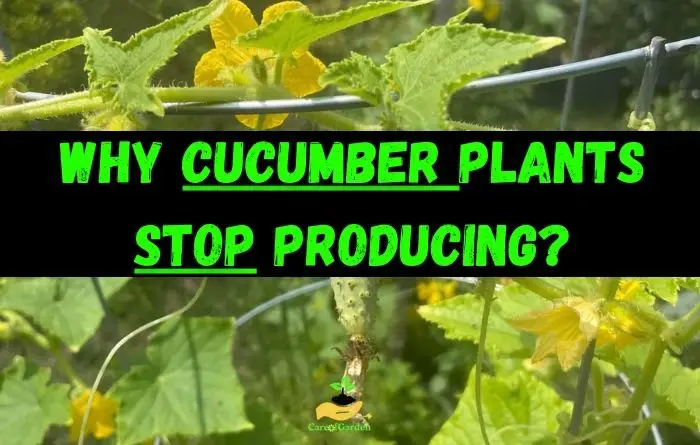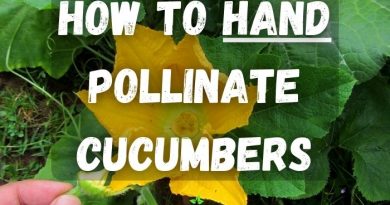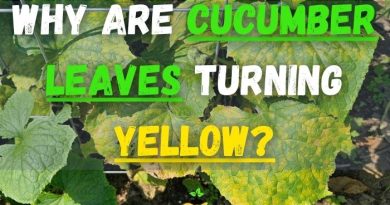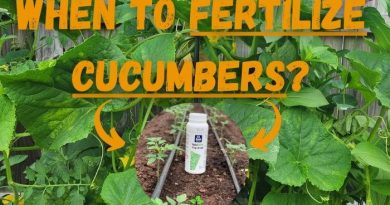Why Cucumber Plants Stop Producing? 5 Reasons Explained!
Cucumbers are a popular and easy-to-grow vegetable that can provide a bountiful harvest if properly cared for. However, sometimes cucumber plants may stop producing fruits, leaving gardeners wondering what went wrong. In this article, we will explore the common reasons cucumber plant stopped producing and provide practical solutions to help you get them back to producing tasty and healthy cucumbers.
Cucumber plants stop producing fruits due to lack of pollination, overcrowding, environmental stress, pest and disease pressure, nutrient deficiencies, and improper watering. Optimal growing conditions, regular monitoring, and pest control can help prevent these issues and ensure continuous cucumber production.
Reasons Why Cucumber Plants Stop Producing
1. Lack of Pollination
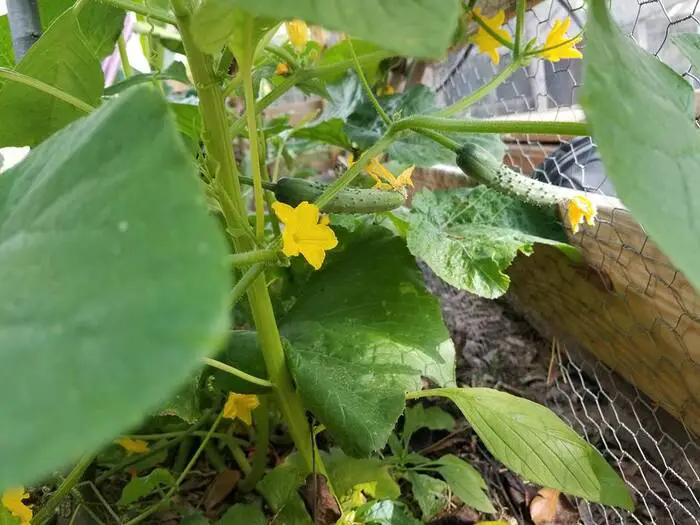
When cucumber plants don’t get pollinated, it can cause them to stop producing fruit. Pollination is crucial for cucumber plants because it kickstarts the development of fruits.
Let’s see how this works!
Cucumbers have both male and female flowers on the plant, so for fruit to grow, pollen from the male flowers needs to reach and fertilize the female flowers.
If the female flowers aren’t pollinated, they won’t be fertilized, and without fertilization, no fruits will form.
When there’s a shortage of pollinators like bees or if the weather conditions aren’t ideal for pollination, such as during rainy days, the rate of pollination may be low. This can lead to fewer fruits being produced and a lower fruit yield.
Recognizing signs of pollination deficiency is crucial:
- One indication for lack of pollination is the presence of malformed or distorted fruit.
- Another sign is when flowers fall off before they can produce any fruit.
- In some instances, the flowers may not even open, clearly indicating a lack of pollination.
Solution
I suggest you start pollinating your cucumber plants by hand as a solution.
To do this, use a small brush or cotton swab and try to transfer the pollen from the male flower to the female flower. The second option I use for transferring pollen is to give my cucumbers a gentle shake.
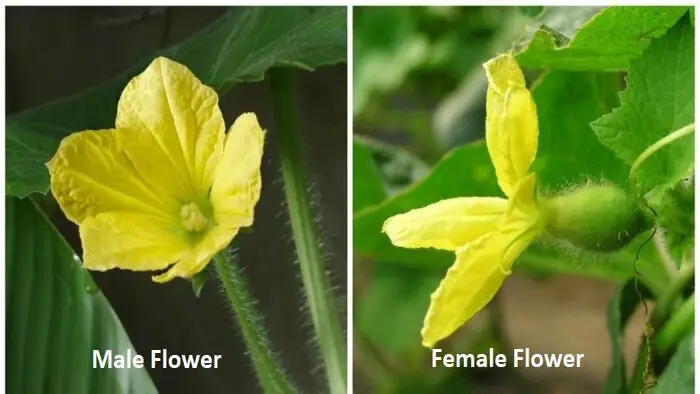
Another solution is to attract more pollinators to your garden. You can do this by planting more bee-friendly flowers or by introducing mason bees or other types of pollinators to your garden.
2. Environmental Factors
Extreme temperature variations, insufficient watering and unfavorable soil conditions can all contribute to the stress experienced by cucumber plants ultimately resulting in a decline in their productivity.
Here is a table with environmental factors that can cause cucumber plants to stop producing:
| Environmental Factors | Description | Solutions |
|---|---|---|
| High temperatures | Cucumber plants may stop producing fruits if exposed to prolonged heat above 90°F (32°C). | Provide shade, mulch, and regular watering during hot spells. |
| Low temperatures | Cucumber plants can be damaged by cold temperatures, especially below 50°F (10°C). | Use row covers, cloths, or plastic tunnels to protect cucumber plants from cold snaps. |
| Lack of light | Cucumber plants need at least 6-8 hours of direct sunlight per day to thrive and produce fruits. | Move plants to a sunnier location or use reflective materials to increase light exposure. |
| Water stress | Cucumber plants require consistent moisture to produce well, but overwatering or underwatering can lead to stress and reduced yields. | Water deeply and regularly, but avoid waterlogging the soil or letting it dry out completely. |
2.1 Extreme Temperatures
Extreme temperatures can have negative effects on cucumber plants, causing them to stop producing in various ways:
- Heat stress: When cucumber plants are exposed to prolonged high temperatures above 90°F (32°C), they may experience heat stress. This can result in dropped flowers ultimately reducing the overall yield.
- Cold stress: Conversely, when cucumber plants are exposed to low temperatures below 50°F (10°C), they may encounter cold stress. This not only slows down cucumber growth but also stops their production capabilities.
- Temperature fluctuations: During extreme temperature fluctuations, especially during flowering stages, cucumber plants might decide to drop their flowers as a survival mechanism. By doing so, they prioritize their energy towards sustaining themselves rather than reproduction. As a consequence, there is a significant reduction in fruit production as resources get channeled towards vegetative growth.
Solution
To protect cucumber production from the effects of extreme temperatures, it is essential to establish optimal growing conditions. This growing condition I use for cold temperatures involves covering the cucumber rows with cloth or plastic tunnels.
I always choose cucumber varieties that are well adapted to my climate and try to plant them to minimize exposure to extreme temperatures. In hot temperatures, I try to shade my cucumbers and water them regularly.
2.2 Overwatering and Underwatering
When it comes to cucumber plants, both overwatering and underwatering can have negative effects on their productivity in various ways.
Overwatering
As you may know, cucumber requires well-draining soil and too much water will make the roots oversaturated with water preventing them from accessing the oxygen and nutrients necessary for fruit production. As a results your cucumber will have small flowers and fewer fruits.
Flower drop occurs when the flowers don’t get the right conditions to develop, so they fall off before they can become fruits. Fruit abortion is when the stressed plant gives up on young fruits, which means fewer cucumbers for you.
One other damage overwatering does to your cucumber is by stripping away essential nutrients from the soil and stimulate the appearance of fungal diseases like powdery mildew and downy mildew.
These diseases can harm the leaves and stop photosynthesis. Additionally, overwatering may cause excessive vegetative growth, delaying the cucumbers’ ability to flower and produce fruits as it prioritizes stem and leaf development.
Underwatering
Conversely, if cucumber plants do not receive enough water, their roots may dry out which makes it difficult for them to absorb water and nutrients. This leads to wilting, yellowing of leaves and cucumber not producing fruit.
Underwatered plants often produce smaller quantities of fruits as they conserve water and energy by reducing their reproductive efforts. Furthermore, underwatering increases the risk of pest infestations such as spider mites and thrips that thrive in dry conditions.
Solution
To maintain optimal fruit production, gardeners should strive to provide cucumbers with consistent and balanced watering:
- Proper Watering: Water the cucumber plants deeply and evenly, keeping the soil consistently moist but not waterlogged. Ensure good drainage to prevent waterlogging.
- Mulching: Apply mulch around cucumber plants to retain soil moisture and reduce evaporation.
- Monitor the Soil: Check the soil moisture regularly and adjust watering frequency based on weather conditions and plant needs.
Another useful advice I have for you is to check if the top inch of soil is dry before watering. It’s best to water cucumbers slowly and deeply so that the roots can grow well. It’s also important to refrain from compacting the soil by walking or tilling on it when it is wet.
3. Nutrient Deficiencies
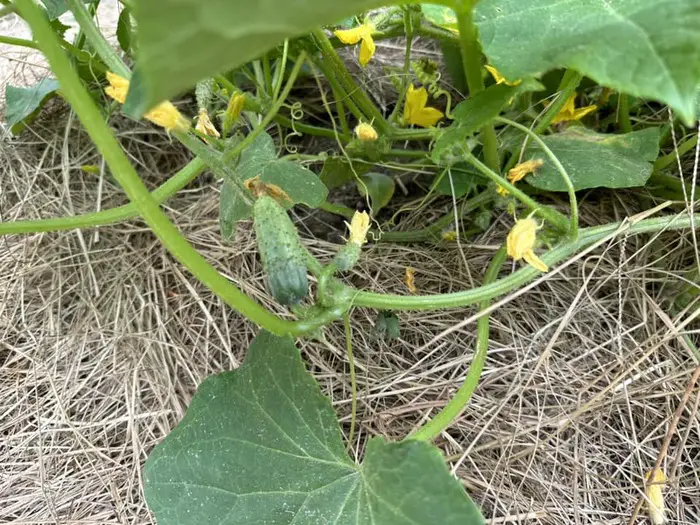
When cucumber plants do not receive nitrogen, phosphorus or potassium their ability to produce flowers may decrease, especially the flowers that eventually turn into fruits. This happens because the plant lacks the energy and resources for growth when its basic needs are not met.
Insufficient nutrients in cucumber plants can also result in lower yields. In these cases, cucumbers may struggle to obtain the required energy and nutrients for fruit growth and development.
In this section, I will discuss the importance of nitrogen, the role of potassium and phosphorus, and how a deficiency, in these nutrients can stop cucumber from producing.
3.1 Role of Nitrogen in Cucumber Production
Nitrogen is one of the most important nutrients for cucumber plants. It is essential for the growth and development of leaves, stems, and fruit. Without enough nitrogen, cucumber production of flowers and, eventually, cucumbers, is stopped.
To ensure my cucumber plants have enough nitrogen, I use a nitrogen-rich fertilizer or add compost to the soil. When using fertilizer, I follow the instructions carefully to avoid over-fertilizing, which can lead to nitrogen burn.
3.2 Role of Potassium in Cucumber Production
Potassium is another essential nutrient for cucumber plants. It plays a crucial role in the overall health of the plant and helps with better water and nutrient uptake, which can enhance the plant’s ability to set and develop fruits.
If my cucumber plants are lacking potassium, I may notice signs of stress, such as wilting or yellowing leaves. To address this, I add a potassium-rich fertilizer or use compost that is high in potassium.
3.3 Role of Phosphorus in Cucumber Production
Phosphorus is important for root development, flower and fruit formation, and energy transfer within the plant.
If my cucumber plants are lacking phosphorus, they may not produce as much fruit, and the fruit may be smaller than usual. To address this, I add a phosphorus-rich fertilizer or use compost that is high in phosphorus.
Solution
| Nutrient Deficiencies | Description | Solutions |
|---|---|---|
| Nitrogen deficiency | Cucumber plants require nitrogen for growth and fruit production, and a lack of nitrogen can lead to yellowing of leaves and reduced yields. | Apply a nitrogen-rich fertilizer or compost, and supplement with foliar sprays or side dressings as needed. |
| Phosphorus deficiency | Cucumber plants require phosphorus for root development and energy transfer, and a lack of phosphorus can lead to stunted growth and poor fruit quality. | Apply a phosphorus-rich fertilizer or bone meal, and improve soil pH and organic matter content if necessary. |
| Potassium deficiency | Cucumber plants require potassium for water regulation and disease resistance, and a lack of potassium can lead to wilting, yellowing, and reduced yields. | Apply a potassium-rich fertilizer or wood ash, and maintain proper soil moisture and pH. |
| Calcium deficiency | Cucumber plants require calcium for cell wall strength and fruit quality, and a lack of calcium can lead to blossom end rot and other disorders. | Apply a calcium-rich fertilizer or gypsum, and maintain proper soil moisture and pH. |
4.Overcrowding
When cucumber plants grow close together they have to fight for resources, like water, nutrients and sunlight which is necessary for properly support the development and maturation of their fruits.
This competition can hinder their growth and productivity ultimately impacting the size, quantity and quality of the fruits they produce.
If cucumber plants become too crowded they might not have room, for airflow. This lack of space can result in increased humidity, reduced ventilation and a higher risk of diseases and pests.
Solution
Cucumbers require adequate space for healthy growth. Space plants 12 to 24 inches apart in rows with 3 to 6 feet between rows. Using trellises or stakes can save space and promote vertical growth, reducing overcrowding issues.
Consider transplanting overcrowded cucumber seedlings to a new location with proper spacing.
5.Pest and Disease
As someone who cultivates cucumber plants, I’m well aware of the challenges posed by diseases and pests, which can significantly stop the productivity of the cucumbers.
In this section, I will discuss some of the common diseases and pests that affect cucumber plants yield and how to manage them.
Cucumber beetles
These small insects, either striped or spotted, can harm the leaves, flowers and fruits of cucumber plants. They can also transmit bacterial wilt, a disease that has the potential to kill your cucumbers. To manage cucumber beetles, you can try using sticky traps, row covers or insecticides specifically meant for cucumbers.
Powdery mildew
This fungal disease can create white powdery patches on leaves and hinder photosynthesis. As a result, it affects the growth and fruit production of cucumber plants.
To prevent powdery mildew from occurring, it’s important to avoid watering from overhead and enhance air circulation around the plants. Additionally, applying fungicides labeled for cucumbers can be helpful.
Downy mildew
Another fungal disease that causes yellowing and curling of leaves along with brown spots on fruits. It significantly reduces yields.
To prevent downy mildew from affecting your cucumber plants, consider using resistant varieties of cucumbers. Also avoid overhead watering and apply fungicides labeled specifically for cucumbers.
Root rot
This soil borne disease leads to wilting, yellowing, stunted growth in plants as well as reduced fruit production.
To minimize the risk of root rot in your cucumber plants ensure you do not overwater them. Improving soil drainage is also important in preventing this disease. Additionally, make sure to use disease free seeds or transplants.
Solution
To prevent these diseases from spreading, it’s crucial to remove infected plants and any debris from your garden.
Fungicides can also help manage fungal infections; however, it’s important to carefully follow the instructions provided on the label and apply them at the recommended time.
How to Identify When a Cucumber Plant has Stopped Producing
Here is a table with signs that a cucumber plant has stopped producing:
| Signs That a Cucumber Plant has Stopped Producing | Description |
|---|---|
| No new flowers | Cucumber plants need to produce flowers before they can produce fruits. If the plant has stopped producing new flowers, it may have completed its reproductive cycle or may be facing environmental stresses, such as extreme temperatures, lack of light, or nutrient deficiencies. |
| No new growth | Cucumber plants need to grow new leaves and stems in order to support fruit production. If the cucumber has stopped growing new leaves and stems, it may have exhausted its resources or may be facing environmental stresses, such as water stress, pest infestations, or diseases. |
| Yellowing and wilting leaves | Cucumber plants that are no longer producing may start to show signs of stress, such as yellowing and wilting leaves, especially the older ones. This may be due to nutrient deficiencies, pest infestations, or environmental stresses, and can lead to reduced yields and fruit quality. |
| Small and misshapen fruits | Cucumber plants that are no longer producing may still have some fruits on the vine, but these fruits may be smaller and misshapen than usual. This may be due to poor pollination, nutrient deficiencies, or pest infestations, and can indicate that the plant is no longer able to support healthy fruit growth. |
How to get a cucumber plant to start producing again
| Factors That Influence Cucumber Production | Description |
|---|---|
| Temperature | Cucumber plants prefer moderate temperatures around 70-75°F (21-24°C) and may stop producing fruits if exposed to prolonged heat above 90°F (32°C). |
| Light | Cucumber plants need at least 6-8 hours of direct sunlight per day to thrive and produce fruits. |
| Soil Quality | Cucumber plants require well-drained, fertile soil with a pH of 6.0-7.0 and sufficient organic matter, nutrients, and water. |
| Pests | Cucumber plants are prone to various pests such as cucumber beetles, aphids, mites, and thrips, which can damage leaves, flowers, and fruits and reduce yields. |
Here are a few helpful steps to get a cucumber plant to start producing again:
- Check the Cucumber: Examine the plant for pests, diseases, or nutrient issues. Taking care of these problems can improve its health and fruiting.
- Water Properly: Make sure to water consistently and adequately. Avoid overwatering or underwatering, as it can affect fruit production.
- Fertilize Right: Apply balanced fertilizer with essential nutrients like nitrogen, phosphorus, and potassium according to recommendations.
- Pollination Matters: Attract pollinators or consider hand-pollinating the flowers for better fruit set.
- Sunlight Needs: Ensure the plant gets 6-8 hours of direct sunlight daily for healthy fruiting.
- Pruning and Thinning: Remove dead or diseased leaves for improved airflow, and thin overcrowded fruits for better quality.
- Healthy Environment: Monitor and control pests and diseases, keeping the growing area clean and well-maintained.
- Harvest Timely: Harvest ripe cucumbers promptly to encourage more fruit production.
When do cucumber plants stop producing?
For most cucumber varieties, the fruiting period lasts for about 6-8 weeks, starting from the time of first harvest. Throughout this time the plants consistently generate flowers and fruits granted that the growing conditions remain favorable and the plants maintain health.
Towards the end of the season, as the weather cools down and the days shorten, cucumber may slow down their growth and fruiting, and may eventually stop producing altogether.
However, some cucumber varieties are more tolerant of cooler temperatures and shorter days, and may continue to produce fruits until the first frost or freeze.
Frequently Asked Questions
Cucumber plants may stop producing fruits due to overcrowding, environmental stress, pest and disease pressure, nutrient deficiencies, and aging. Optimal growing conditions, regular monitoring, and pest control can help prevent these issues and ensure continuous cucumber production.
If your cucumber plants have stopped producing cucumbers, check for possible issues like nutrient deficiencies, pests, or diseases, and take appropriate corrective measures.
Depending on the climate and growing conditions, this can happen around September or October. Most varieties of cucumbers will stop producing after about 2 months. For instance, an Armenian cucumber typically ceases production in around 8 weeks, while an English cucumber can take up to 12 weeks.
To extend the cucumber plant’s fruiting period, consider providing protection from extreme temperatures, regular pruning and maintenance, and ensuring proper pollination for continued fruit set.

